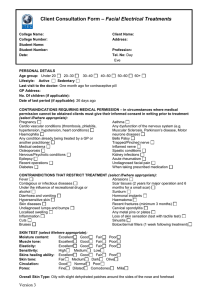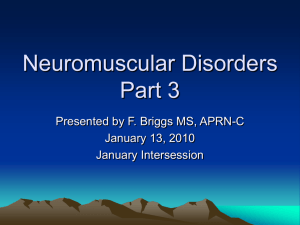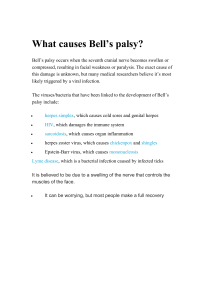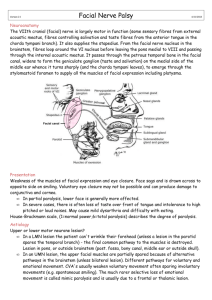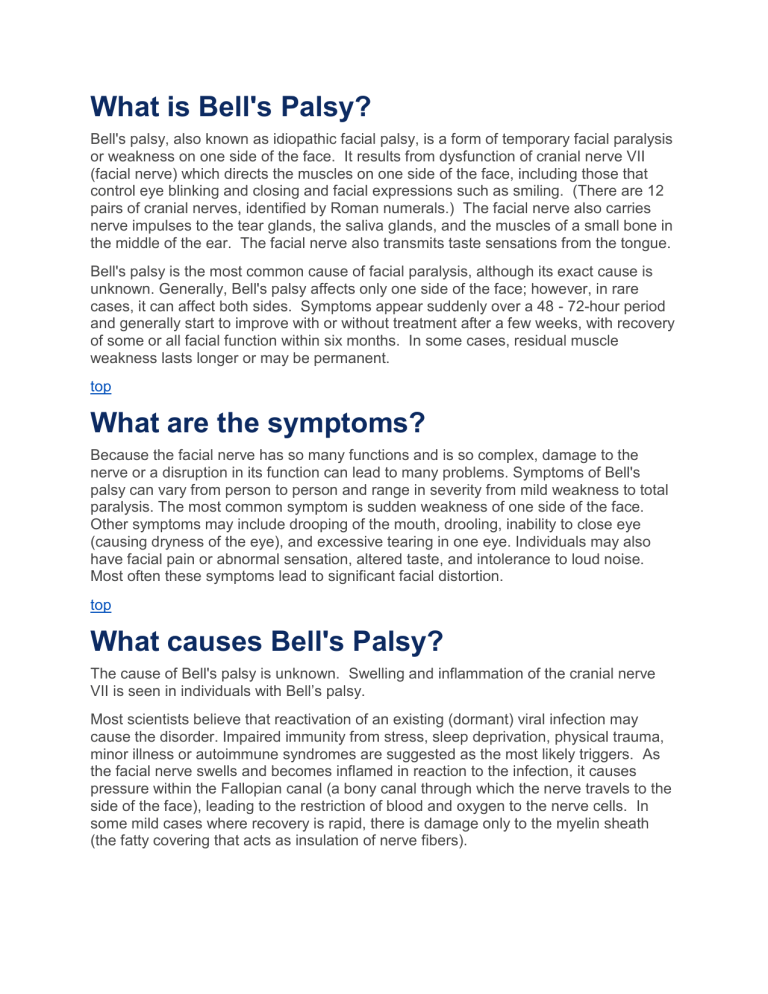
What is Bell's Palsy? Bell's palsy, also known as idiopathic facial palsy, is a form of temporary facial paralysis or weakness on one side of the face. It results from dysfunction of cranial nerve VII (facial nerve) which directs the muscles on one side of the face, including those that control eye blinking and closing and facial expressions such as smiling. (There are 12 pairs of cranial nerves, identified by Roman numerals.) The facial nerve also carries nerve impulses to the tear glands, the saliva glands, and the muscles of a small bone in the middle of the ear. The facial nerve also transmits taste sensations from the tongue. Bell's palsy is the most common cause of facial paralysis, although its exact cause is unknown. Generally, Bell's palsy affects only one side of the face; however, in rare cases, it can affect both sides. Symptoms appear suddenly over a 48 - 72-hour period and generally start to improve with or without treatment after a few weeks, with recovery of some or all facial function within six months. In some cases, residual muscle weakness lasts longer or may be permanent. top What are the symptoms? Because the facial nerve has so many functions and is so complex, damage to the nerve or a disruption in its function can lead to many problems. Symptoms of Bell's palsy can vary from person to person and range in severity from mild weakness to total paralysis. The most common symptom is sudden weakness of one side of the face. Other symptoms may include drooping of the mouth, drooling, inability to close eye (causing dryness of the eye), and excessive tearing in one eye. Individuals may also have facial pain or abnormal sensation, altered taste, and intolerance to loud noise. Most often these symptoms lead to significant facial distortion. top What causes Bell's Palsy? The cause of Bell's palsy is unknown. Swelling and inflammation of the cranial nerve VII is seen in individuals with Bell’s palsy. Most scientists believe that reactivation of an existing (dormant) viral infection may cause the disorder. Impaired immunity from stress, sleep deprivation, physical trauma, minor illness or autoimmune syndromes are suggested as the most likely triggers. As the facial nerve swells and becomes inflamed in reaction to the infection, it causes pressure within the Fallopian canal (a bony canal through which the nerve travels to the side of the face), leading to the restriction of blood and oxygen to the nerve cells. In some mild cases where recovery is rapid, there is damage only to the myelin sheath (the fatty covering that acts as insulation of nerve fibers). Several other conditions can also cause facial paralysis, for example, brain tumor, stroke, myasthenia gravis, and Lyme disease. If no specific cause can be identified, the condition can be diagnosed as Bell's palsy. top Who is at risk? Bell’s palsy affects about 40,000 people in the United States every year. It can affect anyone of any gender and age, but its incidence seems to be highest in those in the 15to 45-year-old age group. Risk factors for Bell’s palsy include pregnancy, preeclampsia, obesity, hypertension, diabetes, and upper respiratory ailments. top How is it diagnosed? A diagnosis of Bell's palsy is made based on clinical presentation—acute facial nerve weakness or paralysis on one side of the face with onset in less than 72 hours—and by ruling out other possible causes of facial paralysis. There is no specific laboratory test to confirm diagnosis of the disorder. Generally, a physician will examine the individual for upper and lower facial weakness. In most cases this weakness occurs to both upper and lower facial muscles, including the forehead, eyelid, and/or mouth. Routine laboratory or imaging studies are not necessary for most cases, but sometimes they can help to confirm the diagnosis or rule out other diseases that can cause facial weakness. A test called electromyography (EMG, which uses very thin wire electrodes that are inserted into a muscle to assess changes in electrical activity that occur during movement and when the muscle is at rest) can confirm the presence of nerve damage and determine the severity and the extent of nerve involvement. Blood tests can sometimes help in diagnosing other concurrent problems such as diabetes and certain infections. Diagnostic imaging using magnetic resonance imaging (MRI) or a computed tomography (CT) scan can rule out other structural causes of pressure on the facial nerve (such as an artery compressing the nerve) and also check the other nerves. top How is it treated? For individuals with new-onset Bell’s palsy, steroids are highly likely to be effective and can increase the probability of recovery of facial nerve function. In most instances, oral steroids should be started within 72 hours of symptom onset if possible, to increase the probability of good facial functional recovery. Some individuals with co-existing conditions may not respond well to or be able to take steroid drugs. Antiviral agents (in addition to steroids) might increase the probability of recovery of facial function, although their benefit has not been clearly established. Analgesics such as aspirin, acetaminophen, or ibuprofen may relieve pain. Because of possible drug interactions, individuals taking prescription medicines should always talk to their doctors before taking any over-the-counter drugs. Another important factor in treatment is eye protection. Bell's palsy can interrupt the eyelid's natural blinking ability, leaving the eye exposed to irritation and drying. Keeping the eye moist and protecting it from debris and injury, especially at night, is important. Lubricating eye drops, such as artificial tears or eye ointments or gels, and eye patches are also effective. Other therapies such as physical therapy, facial massage, or acupuncture may provide a potential small improvement in facial nerve function and pain. In general, decompression surgery for Bell's palsy—to relieve pressure on the nerve—is controversial. On rare occasions, cosmetic or reconstructive surgery may be needed to reduce deformities and correct some damage such as an eyelid that will not fully close or a crooked smile. top What is the prognosis? The prognosis for individuals with Bell's palsy is generally very good. Clinical evidence of improvement occurs spontaneously within three weeks in 85 percent of cases, and most individuals eventually recover normal facial function. Some individuals may be left with mild residual facial weakness or show moderate to severe deficits. Bell’s palsy can have consequences from a previous injury or condition, such as involuntary mouth movements when trying to blink the eyes or incomplete recovery of facial muscle weakness resulting in trouble speaking or forming words (dysarthria). top What research is being done? The mission of the National Institute of Neurological Disorders and Stroke (NINDS) is to seek fundamental knowledge about the brain and nervous system and to use the knowledge to reduce the burden of neurological disease. The NINDS is a component of the National Institutes of Health (NIH), the leading supporter of biomedical research in the world. The NINDS conducts and supports an extensive research program of basic science to increase understanding of how the nervous system works and what causes the system to sometimes go wrong, leading to dysfunction. Part of this research program focuses on learning more about the circumstances that lead to nerve damage and the conditions that cause injuries and damage to nerves. For example, in one research project, scientists are studying two genes to identify the molecular mechanisms involved in the regeneration of nerve projections (axons) to their original targets. An understanding of how to regenerate peripheral nerves may lead to ways to prevent nerve damage and injuries from occurring. Additional projects seek to identify the mechanisms and consequences of neuroinflammation on peripheral nerve function. Knowledge gained from this research may help scientists find the definitive cause of Bell's palsy, leading to the discovery of new effective treatments for the disorder. top Where can I get more information? For more information on neurological disorders or research programs funded by the National Institute of Neurological Disorders and Stroke, contact the Institute's Brain Resources and Information Network (BRAIN) at:
